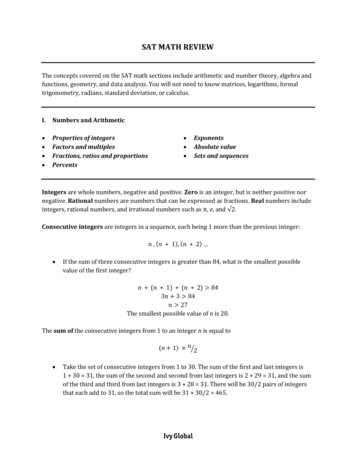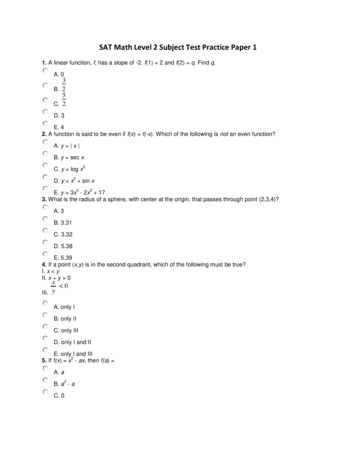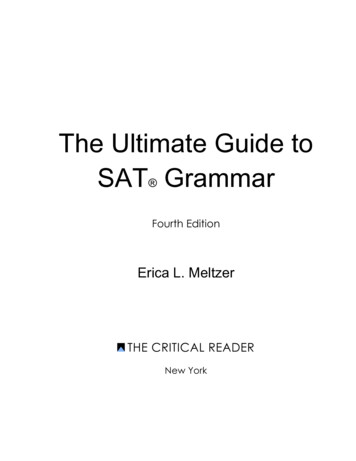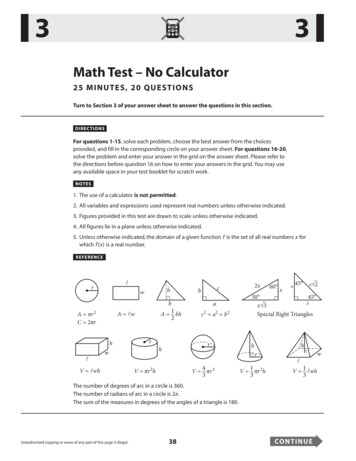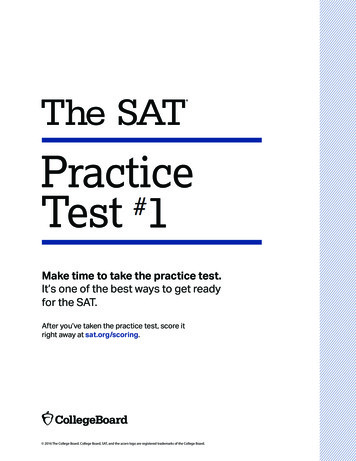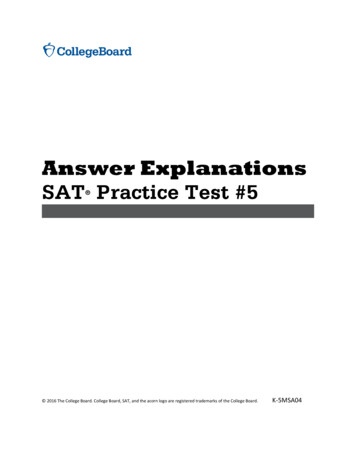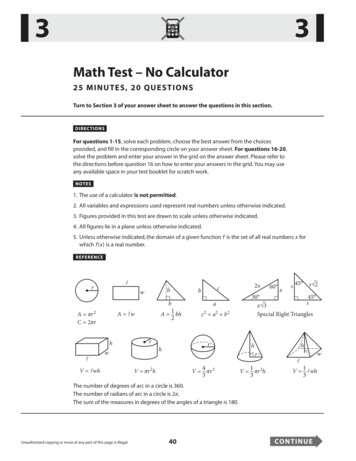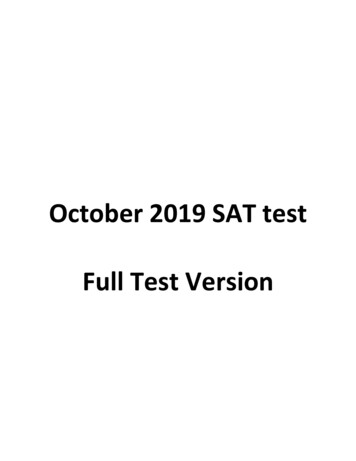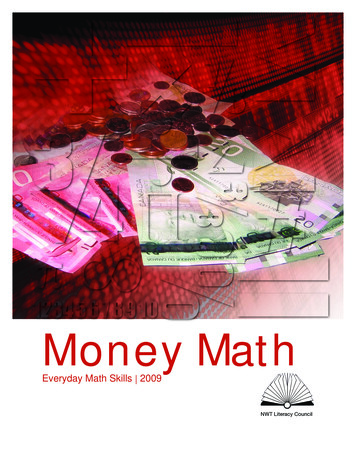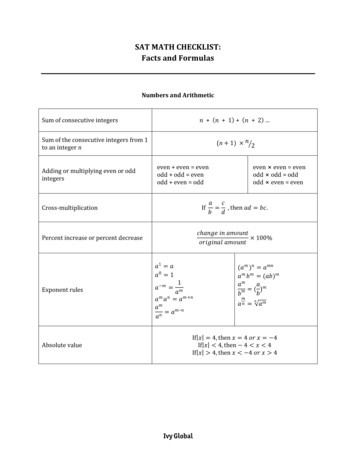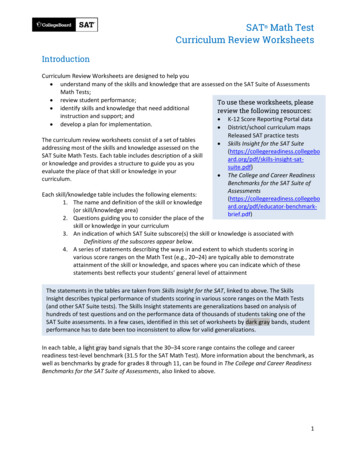
Transcription
SAT Math TestCurriculum Review WorksheetsIntroductionCurriculum Review Worksheets are designed to help you understand many of the skills and knowledge that are assessed on the SAT Suite of AssessmentsMath Tests; review student performance;To use these worksheets, please identify skills and knowledge that need additionalreview the following resources:instruction and support; and K-12 Score Reporting Portal data develop a plan for implementation. District/school curriculum mapsThe curriculum review worksheets consist of a set of tablesaddressing most of the skills and knowledge assessed on theSAT Suite Math Tests. Each table includes description of a skillor knowledge and provides a structure to guide you as youevaluate the place of that skill or knowledge in yourcurriculum. Released SAT practice testsSkills Insight for the SAT f/skills-insight-satsuite.pdf)The College and Career ReadinessBenchmarks for the SAT Suite d.org/pdf/educator-benchmarkbrief.pdf)Each skill/knowledge table includes the following elements:1. The name and definition of the skill or knowledge(or skill/knowledge area)2. Questions guiding you to consider the place of theskill or knowledge in your curriculum3. An indication of which SAT Suite subscore(s) the skill or knowledge is associated withDefinitions of the subscores appear below.4. A series of statements describing the ways in and extent to which students scoring invarious score ranges on the Math Test (e.g., 20–24) are typically able to demonstrateattainment of the skill or knowledge, and spaces where you can indicate which of thesestatements best reflects your students’ general level of attainmentThe statements in the tables are taken from Skills Insight for the SAT, linked to above. The SkillsInsight describes typical performance of students scoring in various score ranges on the Math Tests(and other SAT Suite tests). The Skills Insight statements are generalizations based on analysis ofhundreds of test questions and on the performance data of thousands of students taking one of theSAT Suite assessments. In a few cases, identified in this set of worksheets by dark gray bands, studentperformance has to date been too inconsistent to allow for valid generalizations.In each table, a light gray band signals that the 30–34 score range contains the college and careerreadiness test-level benchmark (31.5 for the SAT Math Test). More information about the benchmark, aswell as benchmarks by grade for grades 8 through 11, can be found in The College and Career ReadinessBenchmarks for the SAT Suite of Assessments, also linked to above.1
SAT Math TestCurriculum Review WorksheetsSubscoresThe set of tables in this document includes abbreviations for the three subscores associated with theSAT Suite Math Tests. Subscores identify areas of concentration on the tests and consequently havepotential instructional value.The three subscores associated with the Math Tests are as follows: Heart of Algebra (HOA): Questions that assess students’ ability to analyze, fluently solve, andcreate linear equations and inequalities. Students will also be expected to analyze and fluentlysolve equations and systems of equations using multiple techniques.Problem Solving and Data Analysis (PSD): Questions that focus on quantities and theirunits, proportional relationships, percentages, univariate and bivariate data analysis, probability,and core concepts of statistics.Passport to Advanced Math (PAM): Questions that focus on the structure of expressionsand the ability to analyze, manipulate, and rewrite these expressions. Students will also beexpected to analyze, fluently solve, and create non-linear equations.Note that some Math Test questions do not contribute to any subscore. This is not to suggestthat those questions and the skills and knowledge they assess are unimportant; rather, thosequestions focus on other skills and knowledge important to college and career readiness.The College Board decided to focus on these subscores based on the best available evidence aboutessential college and career readiness and success requirements.ProcedureThe following is a step-by-step guide for using this set of worksheets.1. Understand how your students are performing on the SAT Suite Math Test.a. Review your school and district mean performance on the Math Test and associatedsubscores (HOA, PSD, and PAM). Record this performance data in the appropriatespaces in the “How Are Students Performing?” table.b. Considering the performance data and the subscore definitions, identify whichdomain(s) have the most potential for improvement in the space below the table.2. Familiarize yourself with the Math Test.a. Review Math Test directions, questions, and answer explanations from the released SATpractice tests to better understand how skills and knowledge are assessed.b. Use the subscore information in this document to better understand how Heart ofAlgebra, Problem Solving and Data Analysis, and Passport to Advanced Math aremeasured on the test.2
SAT Math TestCurriculum Review Worksheets3. Analyze your curriculum. Using this set of curriculum review worksheets and your curriculummaps, identify for each skill/knowledge (area) in the tables below(e.g., Development / Proposition)Explicit is stressed herea. whether the skill/knowledge is explicitly taught in yourbecause instruction oftencurriculum;touches onb. (if “yes”) in which course(s)/grade level(s) theskills/knowledge withoutskill/knowledge is explicitly taught;directly addressing them,c. in which course(s)/grade level(s) students mustmaking studentdemonstrate proficiency in this skill/knowledge; andacquisition less certain.d. which of the (generally) four levels of performancedescribed (e.g., at the 20–24 score range on the Math Tests) best represents the highestlevel at which your students generally demonstrate understanding of theskill/knowledge (You may instead indicate that your students’ attainment is “below” thelowest level represented or “above” the highest level represented.)4. Develop an action plan.a. Based on the data gathered above, identify three to fiveUse the Notes space toskills/knowledge (or skill/knowledge areas, such as Sentencetrack questions, plansStructure) to devote consistent attention to.for addressing issues,b. Use the Skills Insight Suggestions for Improvement as well asand next steps.other resources to design instructional strategies to fosterimprovement.c. Set a time line for implementation of the strategies.d. List the resources needed for implementation.e. Identify means of assessing, formally or informally, whether teaching and learning haveimproved in these areas.3
SAT Math TestCurriculum Review WorksheetsHow Are Students Performing?In the spaces below record the mean scores at the school and district level for the Math Test and for theassociated subscores. (Definitions of the subscores can be found in the introductory materials for thisset of curriculum review worksheets, and the skill/knowledge tables below show how individualskills/knowledge map onto the subscores.) In the space below the table, identify opportunities forimprovement.Math TestHeart of AlgebraProblem Solvingand Data AnalysisPassport toAdvanced MathSchoolDistrictOpportunities for improvement:4
SAT Math TestCurriculum Review WorksheetsSAT Math Test Academic Skills and KnowledgeThis area focuses on linear equations in one variable.Content Description: The student will:1. Create and use linear equations in one variable to solve problems in a variety of contexts.2. Create a linear equation in one variable, and when in context interpret solutions in terms of thecontext.3. Solve a linear equation in one variable, making strategic use of algebraic structure.4. For a linear equation in one variable,a. interpret a constant, variable, factor, or term in a context;b. determine the conditions under which the equation has no solution, a unique solution, orinfinitely many solutions.5. Fluently solve a linear equation in one variable.Is this skill/knowledge explicitly taught in your curriculum?YesNoIf “yes,” in which course(s)/gradelevel(s) is this skill/knowledgeexplicitly taught? When areScore Substudents expected torange scoreSkill/knowledgedemonstrate proficiency?15–19 HOACreate a simple expression in one variable thatrepresents a contextEvaluate a one-variable expression by substitutinga value for the variable20–24 HOACreate an expression or equation in one variablethat models a context25–29 HOASolve a linear equation in one variableInterpret a term from a linear equation in onevariable in the form ax b c30–34 HOADetermine the conditions under which a linearequation in one variable has no solution, onesolution, or infinitely many solutionsSolve a linear equation in one variable that requirescomputation with fractions or decimal35–40 HOACreate and solve a linear equation in one variablerepresenting a context, utilizing insight to identifythe correct coefficients and constants in theequationMake connections between differentrepresentations of linear equations in one variable;these representations often include symbolicrepresentations, which may contain variableconstant5
SAT Math TestCurriculum Review WorksheetsNotes6
SAT Math TestCurriculum Review WorksheetsSAT Math Test Academic Skills and KnowledgeThis area focuses on linear functions.Content Description: The student will:1. Create and use linear functions to solve problems in a variety of contexts.2. Create a linear function to model a relationship between two quantities.3. For a linear function that represents a context,a. interpret the meaning of an input/output pair, constant, variable, factor, or term based onthe context, including situations where seeing structure provides an advantage;b. given an input value, find and/or interpret the output value using the given representation;c. given an output value, find and/or interpret the input value using the given representation,if it exists.4. Make connections between verbal, tabular, algebraic, and graphical representations of a linearfunction bya. deriving one representation from the other;b. identifying features of one representation given another representation;c. determining how a graph is affected by a change to its equation.5. Write the rule for a linear function given two input/output pairs or one input/output pair and therate of change.Is this skill/knowledge explicitly taught in your curriculum?YesNoIf “yes,” in which course(s)/gradelevel(s) is this skill/knowledgeexplicitly taught? When are studentsScore Subexpected to demonstraterange scoreSkill/knowledgeproficiency?20–24 HOAStudents scoring in this range are not able todemonstrate consistent attainment of thesecontent descriptions25–29 HOAInterpret a term from a linear equation in twovariables in slope-intercept form30–34 HOAMake connections between differentrepresentations of linear functions35–40 HOAMake connections between differentrepresentations of linear functions; theserepresentations often include symbolicrepresentations, which may contain variableconstantNotes7
SAT Math TestCurriculum Review WorksheetsSAT Math Test Academic Skills and KnowledgeThis area focuses on linear equations in two variables.Content Description: The student will:1. Create and use a linear equation in two variables to solve problems in a variety of contexts.2. Create a linear equation in two variables to model a constraint or condition on two quantities.3. For a linear equation in two variables that represents a context,a. interpret a solution, constant, variable, factor, or term based on the context, includingsituations where seeing structure provides an advantage;b. given a value of one quantity in the relationship, find a value of the other, if it exists.4. Make connections between tabular, algebraic, and graphical representations of a linear equation intwo variables bya. deriving one representation from the other;b. identifying features of one representation given the other representation;c. determining how a graph is affected by a change to its equation.5. Write an equation for a line given two points on the line, one point and the slope of the line, or onepoint and a parallel or perpendicular line.Is this skill/knowledge explicitly taught in your curriculum?YesNoIf “yes,” in which course(s)/gradelevel(s) is this skill/knowledgeexplicitly taught? When are studentsScore Subexpected to demonstraterange scoreSkill/knowledgeproficiency?20–24 HOACreate a linear expression or equation in twovariables that models a context25–29 HOAInterpret a term from a linear equation in twovariables in standard formCreate a linear equation in two variables thatmodels a complex contextMake connections between differentrepresentations (graphs, equations, tables,etc.) of linear relationships between twovariablesIdentify a key feature of one representation(graph, equation, table, etc.) of a linearrelationship based on information about adifferent representation30–34 HOACreate and use linear relationships to solve aproblemInterpret terms in linear relationships shownin graphs or in linear equations that are not instandard form or slope-intercept formMake connections between differentrepresentations linear equations in twovariables8
SAT Math TestCurriculum Review Worksheets35–40HOACreate and use a linear equation in twovariables, where the equation represents acontext, utilizing insight to identify the correctcoefficients and constants in the equationInterpret a term in a linear relationship that ispresented as an equation or a graph withinsight and precisionMake connections between differentrepresentations of linear equations in twovariables; these representations often includesymbolic representations, which may containvariable constantNotes9
SAT Math TestCurriculum Review WorksheetsSAT Math Test Academic Skills and KnowledgeThis area focuses on systems of two linear equations in two variables.Content Description: The student will:1. Create and use a system of two linear equations in two variables to solve problems in a variety ofcontexts.2. Create a system of linear equations in two variables, and when in context interpret solutions interms of the context.3. Make connections between tabular, algebraic, and graphical representations of the system byderiving one representation from the other.4. Solve a system of two linear equations in two variables, making strategic use of algebraic structure.5. For a system of linear equations in two variables,a. interpret a solution, constant, variable, factor, or term based on the context, includingsituations where seeing structure provides an advantage;b. determine the conditions under which the system has no solution, a unique solution, orinfinitely many solutions.6. Fluently solve a system of linear equations in two variables.Is this skill/knowledge explicitly taught in your curriculum?YesNoIf “yes,” in which course(s)/gradelevel(s) is this skill/knowledgeexplicitly taught? When are studentsScore Subexpected to demonstraterange scoreSkill/knowledgeproficiency?20–24 HOAStudents scoring in this range are not able todemonstrate consistent attainment of thesecontent descriptions25–29 HOACreate a system of two linear equations in twovariables that models a contextSolve a system of two linear equations in twovariables30–34 HOAMake connections between differentrepresentations of systems of two linearequations in two variablesDetermine the conditions under which asystem of two linear equations in twovariables written in standard form has nosolution, one solution, or infinitely manysolutionsSolve a system of linear equations in twovariables that requires computation withfractions or decimal10
SAT Math TestCurriculum Review Worksheets35–40HOAMake connections between differentrepresentations of systems of two linearequations in two variables; theserepresentations often include symbolicrepresentations, which may contain variableconstantDetermine the conditions under which asystem of two linear equations in twovariables written in nonstandard form has nosolution, one solution, or infinitely manysolutionsNotes11
SAT Math TestCurriculum Review WorksheetsSAT Math Test Academic Skills and KnowledgeThis area focuses on linear inequalities in one or two variables.Content Description: The student will:1. Create and use linear inequalities in one or two variables to solve problems in a variety of contexts.2. Create linear inequalities in one or two variables, and when in context interpret the solutions interms of the context.3. For linear inequalities in one or two variables, interpret a constant, variable, factor, or term,including situations where seeing structure provides an advantage.4. Make connections between tabular, algebraic, and graphical representations of linear inequalitiesin one or two variables by deriving one from the other.5. Given a linear inequality or system of linear inequalities, interpret a point in the solution set.Is this skill/knowledge explicitly taught in your curriculum?YesNoIf “yes,” in which course(s)/gradelevel(s) is this skill/knowledgeexplicitly taught? When are studentsScore Subexpected to demonstraterange scoreSkill/knowledgeproficiency?20–24 HOAFind a number that satisfies a linear inequalityin context25–29 HOACreate an inequality in one or two variablesbased on a verbal description of a relationshipSolve linear equations in which a linearexpression is used as a variable30–34 HOACreate an inequality in one or two variablesthat represents a relationshipMake connections between differentrepresentations of linear inequalities35–40 HOACreate and use an inequality in one or twovariables, where the equation represents acontext, utilizing insight to identify the correctcoefficients and constants in the inequalityMake connections between differentrepresentations of linear inequalities; theserepresentations often include symbolicrepresentations, which may contain variableconstantNotes12
SAT Math TestCurriculum Review WorksheetsSAT Math Test Academic Skills and KnowledgeThis area focuses on Ratios, rates, proportional relationships, and units.Content Description: The student will:1. Apply proportional relationships, ratios, rates, and units in a wide variety of contexts. Examplesinclude but are not limited to scale drawings and problems in the natural and social sciences.2. Solve problems involvinga. derived units, including those that arise from products (e.g., kilowatt-hours) and quotients(e.g., population per square kilometer);b. unit conversion, including currency exchange and conversion between differentmeasurement systems.3. Understand and use the fact that when two quantities are in a proportional relationship, if onechanges by a scale factor, then the other also changes by the same scale factor.Is this skill/knowledge explicitly taught in your curriculum?YesNoIf “yes,” in which course(s)/gradelevel(s) is this skill/knowledgeexplicitly taught? When are studentsScore Subexpected to demonstraterange scoreSkill/knowledgeproficiency?15–19 PSDCreate a rate based on a context and use therate to solve a simple problemUse common English Conversions (e.g., 1 hour 60 minutes, 1 foot 12 inches) to find andequivalent rate20–24 PSDIdentify a ratio or a fraction based on acontextUse proportions to compare quantities andfind missing valuesSolve problems that involve converting unitswithin the same measurement system25–29 PSDIdentify, interpret, and use ratios, proportions,and rates, expressing them in equivalentforms, to solve real-world problemsConvert units one or more times to solve acontextual problemEstimate/find a proportion, rate, percent, orfraction from a graph or a tableSolve problems involving derived units or unitconversion between different measurementsystems13
SAT Math TestCurriculum Review Worksheets30–34PSD35–40PSDSolve mixture problems, using proportionalreasoningInterpret and compare unit rates, ratios, orrates of change that are based in a contextSolve multistep problems involving rates,proportions, unit conversion, percentages, anddensityConvert units and create and use ratios,proportions, percents, rates, and unit rates tosolve problemsNotes14
SAT Math TestCurriculum Review WorksheetsSAT Math Test Academic Skills and KnowledgeThis area focuses on percentages.Content Description: The student will:1. Use percentages to solve problems in a variety of contexts. Examples include, but are not limitedto, discounts, interest, taxes, tips, and percent increases and decreases for many differentquantities.2. Understand and use the relationship between percent change and growth factor (5% and 1.05, forexample); include percentages greater than or equal to 100%.Is this skill/knowledge explicitly taught in your curriculum?YesNoIf “yes,” in which course(s)/gradelevel(s) is this skill/knowledgeexplicitly taught? When are studentsScore Subexpected to demonstraterange scoreSkill/knowledgeproficiency?20–24 PSDSolve problems that involve percentages25–29 PSDSolve multistep problems using percentages30–34 PSDSolve multistep problems involvinginterpretation of a constant rate of changeassociated with a percent increase or apercent decrease35–40 PSDStudents scoring in this range consistentlydemonstrate attainment of these contentdescriptionsNotes15
SAT Math TestCurriculum Review WorksheetsSAT Math Test Academic Skills and KnowledgeThis area focuses on one-variable data: distributions and measures of center and spread.Content Description: The student will:1. Choose an appropriate graphical representation for a given data set.2. Interpret information from a given representation of data in context.3. Analyze and interpret numerical data distributions represented with frequency tables, histograms,dot plots, and boxplots.4. For quantitative variables, calculate, compare, and interpret mean, median, and range. Interpret(but don’t calculate) standard deviation.5. Compare distributions using measures of center and spread, including distributions with differentmeans and the same standard deviations and ones with the same mean and different standarddeviations.6. Understand and describe the effect of outliers on mean and median.7. Given an appropriate data set, calculate the mean.Is this skill/knowledge explicitly taught in your curriculum?YesNoIf “yes,” in which course(s)/gradelevel(s) is this skill/knowledgeexplicitly taught? When are studentsScore Subexpected to demonstraterange scoreSkill/knowledgeproficiency?20–24 HOAStudents scoring in this range are not able todemonstrate consistent attainment of thesecontent descriptions25–29 HOACalculate mean, median, or range for a set ofdata presented in various ways30–34 HOAFor a set of data, calculate, compare, andinterpret mean, median, or range in context35–40 HOAFind how the mean, median, and range of dataare affected by a change in the data setFind the median of data from a frequencytableCompare measures of center and spread oftwo data distributions represented visuallyNotes16
SAT Math TestCurriculum Review WorksheetsSAT Math Test Academic Skills and KnowledgeThis area focuses on two-variable data: models and scatterplots.Content Description: The student will:1. Using a model that fits the data in a scatterplot, compare values predicted by the model to valuesgiven in the data set.2. Interpret the slope and intercepts of the line of best fit in context.3. Given a relationship between two quantities, read and interpret graphs and tables modeling therelationship.4. Analyze and interpret data represented in a scatterplot or line graph; fit linear, quadratic, andexponential models.5. Select a graph that represents a context, identify a value on a graph, or interpret information onthe graph.6. For a given function type (linear, quadratic, exponential), choose the function of that type that bestfits given data.7. Compare linear and exponential growth.8. Estimate the line of best fit for a given scatterplot; use the line to make predictions.Is this skill/knowledge explicitly taught in your curriculum?YesNoIf “yes,” in which course(s)/gradelevel(s) is this skill/knowledgeexplicitly taught? When are studentsScore Subexpected to demonstraterange scoreSkill/knowledgeproficiency?15–19 PSDRead information presented in simple tablesof simple graphs20–24 PSDRead and interpret contextual informationpresented in a graph or tableIdentify the shape of a graph from a verbaldescription of some of its pointsUse information about a directly proportionalrelationship to describe the graph of therelationship25–29 PSDInterpret the association shown by ascatterplot and, when applicable, use a line ofbest fit to make predictionIdentify a graph of a nonlinear relationshipbetween two variables based on a verbaldescriptionEvaluate a conclusion about informationpresented in a graphRecognize common characteristics of linear orexponential models based on a verbaldescription of a situation17
SAT Math TestCurriculum Review Worksheets30–34PSD35–40PSDAnalyze data presented in a scatterplot anddraw conclusions from the trend shownIdentify the equation of a line that best fits thedata in a scatterplotIdentify an appropriate inference orconclusion based on information from a graphor tableDistinguish between linear and exponentialmodels from information provided verbally orin tablesAnalyze complex data displaysAnalyze graphs of nonlinear relationshipsbetween two quantities, includingrelationships that are not represented by alinear, quadratic, or exponential equationUse scatterplots to make predictionsNotes18
SAT Math TestCurriculum Review WorksheetsSAT Math Test Academic Skills and KnowledgeThis area focuses on probability and conditional probability.Content Description: The student will:1. Compute and interpret probability and conditional probability in simple contexts.2. Understand formulas for probability and conditional probability in terms of frequency.Is this skill/knowledge explicitly taught in your curriculum?YesNoIf “yes,” in which course(s)/gradelevel(s) is this skill/knowledgeexplicitly taught? When are studentsScore Subexpected to demonstraterange scoreSkill/knowledgeproficiency?20–24 PSDStudents scoring in this range are not able todemonstrate consistent attainment of thesecontent descriptions25–29 PSDCalculate a simple conditional probability froma two-way table30–34 PSDCompute conditional probability in differentsettings, including two-way tables35–40 PSDStudents scoring in this range consistentlydemonstrate attainment of these contentdescriptionsNotes19
SAT Math TestCurriculum Review WorksheetsSAT Math Test Academic Skills and KnowledgeThis area focuses on inference from sample statistics and margin of error.Content Description: The student will:1. Use sample mean and sample proportion to estimate population mean and population proportion.Utilize, but do not calculate, margin of error.2. Interpret margin of error; understand that a larger sample size generally leads to a smaller marginof error.Is this skill/knowledge explicitly taught in your curriculum?YesNoIf “yes,” in which course(s)/gradelevel(s) is this skill/knowledgeexplicitly taught? When are studentsScore Subexpected to demonstraterange scoreSkill/knowledgeproficiency?20–24 PSDStudents scoring in this range are not able todemonstrate consistent attainment of thesecontent descriptions25–29 PSDUse sample proportion to estimate theproportion of the population from which thesample was selectedEvaluate a conclusion about the plausiblevalues of a population proportion based onsample data and margin of error30–34 PSDUnderstand sampling variability when thepopulation proportion is estimated usingsample data35–40 PSDStudents scoring in this range consistentlydemonstrate attainment of these contentdescriptionsNotes20
SAT Math TestCurriculum Review WorksheetsSAT Math Test Academic Skills and KnowledgeThis area focuses on evaluating statistical claims: observational studies and experiments.Content Description: The student will:1. With random samples, describe which population the results can be extended to.2. Given a description of a study with or without random assignment, determine whether there isevidence for a causal relationship.3. Understand why random assignment provides evidence for a causal relationship.4. Understand why a result can be extended only to the population from which the sample wasselected.Is this skill/knowledge explicitly taught in your curriculum?YesNoIf “yes,” in which course(s)/gradelevel(s) is this skill/knowledgeexplicitly taught? When are studentsScore Subexpected to demonstraterange scoreSkill/knowledgeproficiency?20–24 PSDStudents scoring in this range are not able todemonstrate consistent attainment of thesecontent descriptions25–29 PSDIdentify bias that may arise from samplingmethods30–34 PSDIdentify the most appropriate sample orsampling method to best answer the questionof interestIdentify the population to which the results ofa survey can be generalized35–40 PSDIdentify the appropriate conclusion to drawfrom a description of a study’s design and thestudy resultsNotes21
SAT Math TestCurriculum Review WorksheetsSAT Math Test Academic Skills and KnowledgeThis area focuses on equivalent expressions.Content Description: The student will:1. Make strategic use of algebraic structure and the properties of operations to identify and createequivalent expressions, includinga. rewriting simple rational expressions;b. rewriting expressions with rational exponents and radicals;c. factoring polynomials.2. Fluently add, subtract, and multiply polynomials.Is this skill/knowledge explicitly taught in your curriculum?YesNoIf “yes,” in which course(s)/gradelevel(s) is this skill/knowledgeexplicitly taught? When are studentsScore Subexpected to demonstraterange scoreSkill/knowledgeproficiency?20–24 PAMUse the distributive property to
2. Familiarize yourself with the Math Test. a. Review Math Test directions, questions, and answer explanations from the released SAT practice tests to better understand how skills and knowledge are assessed. b. Use the subscore infor
